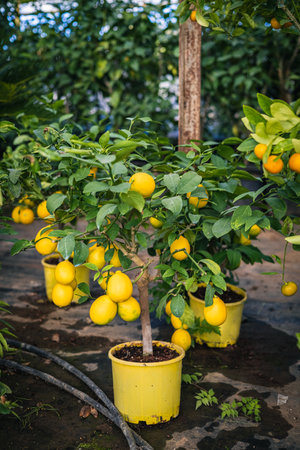1. Climate and Regional Considerations
India’s vast landscape presents unique climatic zones, from the humid coasts of Kerala and West Bengal to the arid regions of Rajasthan and Gujarat. Understanding your local climate is the first step for any home gardener aiming to grow mango or lemon trees. Mangoes thrive in tropical and subtropical climates, preferring hot summers and dry winters, which are common in states like Maharashtra, Andhra Pradesh, and Uttar Pradesh. Lemons, on the other hand, are more tolerant but still require plenty of sunlight and well-drained soil. In southern India, heavy monsoon rainfall can challenge both crops, making raised beds or proper drainage essential. For northern regions where winter temperatures can drop significantly, choosing frost-resistant varieties and providing winter protection is crucial. By aligning your planting strategies with regional weather patterns—such as timing your planting before the monsoon or selecting drought-resistant rootstocks—you give your mango and lemon trees the best chance to flourish in India’s diverse environments.
Soil Health and Native Soil Practices
For mango and lemon trees to thrive in Indian home gardens, understanding the local soil types is essential. Across India, soils can vary widely — from the red laterite soils of Maharashtra, the black cotton soils in Madhya Pradesh, to alluvial soils in Uttar Pradesh and West Bengal. Each type has its unique challenges for fruit tree cultivation.
Dealing with Local Soil Types
Mango and lemon trees prefer well-drained, loamy soil but are quite adaptable. However, heavy clay or saline soils can cause root rot and stunted growth. Sandy soils may drain too quickly, depriving roots of moisture. Here’s a quick reference table for common Indian soil types and recommended solutions:
| Soil Type | State/Region | Common Challenge | Local Solution |
|---|---|---|---|
| Black Cotton Soil | Maharashtra, MP, Gujarat | Poor drainage, compaction | Add sand, organic compost; raised beds |
| Red Laterite Soil | Karnataka, Kerala, Goa | Low fertility, acidic nature | Add cow dung manure, wood ash, green leaf mulch |
| Alluvial Soil | UP, Bihar, West Bengal | Nutrient leaching after rains | Mulching with straw/leaves; compost application before monsoon |
| Sandy Soil | Rajasthan, Coastal Andhra | Poor moisture retention | Add vermicompost; frequent mulching with coconut husk/coir pith |
Traditional Enrichment Techniques: Composting & Cow Dung Use
Composting: Home composting is a time-tested Indian practice. Collect kitchen waste (vegetable peels, fruit scraps), dried leaves (neem, mango), and mix them in a pit or bin. Turn the pile every 15 days. After 2-3 months, you’ll have rich organic matter to improve soil structure and fertility.
Cow Dung: In most Indian villages and cities alike, cow dung is considered ‘Amrit’ for plants. Fresh cow dung should be composted for 1-2 months before use to prevent root burn. Mix well-rotted cow dung into the planting pit or as a top dressing during the growing season. This not only enriches the soil but also improves microbial health.
Tip:
If you live in an apartment or have limited space, try making ‘chamba’—a small compost pot using an earthen pot that can be kept on balconies.
Sustainable Practice:
Avoid chemical fertilisers for home-grown mango and lemon trees whenever possible. Embrace traditional Panchagavya or Jeevamrut preparations for long-term soil vitality.

3. Water Management and Drought Solutions
Water scarcity is a major challenge for home gardeners in many parts of India, especially when growing mango and lemon trees. Both these fruit trees require regular moisture, but many regions face unpredictable rainfall or prolonged dry spells. To tackle this, Indian households have developed innovative and sustainable methods that are well-suited to local conditions.
Rainwater Harvesting: Traditional Wisdom for Modern Gardens
One effective way to address water shortage is rainwater harvesting, a practice deeply rooted in Indian culture. Setting up simple rainwater collection systems—using rooftop channels or barrels—ensures you store precious monsoon water for use during the drier months. Even a small setup can provide enough water for your backyard mango and lemon saplings throughout the year.
Mulching: Conserving Soil Moisture Naturally
Another popular home solution is mulching around the base of your fruit trees with locally available materials like dried leaves, coconut husk, or sugarcane bagasse. Mulching helps reduce evaporation, keeps roots cool, suppresses weed growth, and steadily releases nutrients back into the soil. This method not only saves water but also enhances soil health in the long run.
Local Tips from Indian Gardeners
Many experienced home growers in India recommend watering early in the morning or late evening to minimize evaporation loss. Additionally, using clay pots (matka irrigation) buried near roots allows slow release of water directly to the plant’s base—an age-old technique that is both efficient and eco-friendly. By combining these traditional Indian practices with modern awareness, you can grow healthy mango and lemon trees even in challenging climatic conditions.
4. Dealing with Pests, Diseases, and Local Wildlife
When growing mango and lemon trees at home in India, one of the biggest challenges is protecting them from native pests, diseases, and local wildlife. Many conventional pesticides can harm the environment and human health. Instead, Indian households have a rich tradition of using natural and sustainable solutions that are effective and eco-friendly.
Common Pests and Diseases Affecting Mango & Lemon Trees
| Pest/Disease | Symptoms | Natural Remedy |
|---|---|---|
| Mango Hopper | Curling leaves, sticky residue on new shoots | Spray neem oil solution (30 ml/litre water) every 10 days during flowering season |
| Mealybugs | White cottony patches on stems and fruits | Apply diluted soapnut (reetha) water; introduce ladybird beetles as predators |
| Citrus Leaf Miner | Curled or distorted lemon leaves, silvery trails | Use garlic-chilli spray; prune affected leaves regularly |
| Antracnose (Fungal Disease) | Dark spots on mango/lemon leaves and fruit drop | Apply a mixture of buttermilk (chhaas) and water to infected areas; improve air circulation by proper pruning |
| Bacterial Canker | Sores on branches, gum oozing out | Dab turmeric paste on wounds; use cow dung slurry as a protective wash for trunks |
Sustainable Techniques for Pest Control at Home
- Neem Mulch & Oil: Neem leaves or oil naturally repel many insects. Spread neem mulch around the base of the tree or use neem oil sprays.
- Ash & Cow Urine Spray: Mix wood ash with cow urine and water. Spray this mixture on affected areas to deter fungal infections and some insects—an age-old Indian practice.
- Companion Planting: Grow tulsi (holy basil), marigold, or garlic near your trees. These plants help repel pests like aphids, fruit flies, and caterpillars.
- Physical Barriers: Use jute bags or old sarees to cover young fruits against birds and squirrels without using plastic.
- Encourage Beneficial Insects: Avoid chemical sprays so that natural predators like spiders, dragonflies, and predatory wasps can thrive in your garden.
Tackling Local Wildlife Challenges Sustainably
Indian gardens often face visits from monkeys, birds, or squirrels. To protect your harvest without harming wildlife:
- Netting: Install fine mesh nets over trees during fruiting season.
- Noisy Objects: Hang old CDs or wind chimes to deter birds with sound and reflection.
- Naturally Spicy Sprays: Sprinkle chilli powder mixed with water around the base to keep small mammals away—safe for plants but unpleasant for intruders.
- Cultural Respect: Leave a few fruits for wildlife as a gesture of harmony with nature, following traditional Indian values of co-existence.
Sustainable Gardening Wisdom from Indian Homes
The best way to manage pests and diseases is through regular observation, maintaining plant health with organic composts like gobar khad (cow dung manure), and adopting time-tested desi nuskhe (home remedies). With patience and these local strategies, you can enjoy healthy mangoes and lemons while nurturing both your garden ecosystem and cultural roots.
5. Community Wisdom and Traditional Knowledge
In India, growing mango and lemon trees at home is not just about following modern gardening tips—it is about weaving in the deep-rooted wisdom passed down through generations. Many households still practice traditional Indian farming techniques that have proven effective for centuries. For example, using natural fertilizers like cow dung (gobar) and compost from kitchen waste is a common and eco-friendly way to nourish the soil. Additionally, age-old methods such as mulching with dried leaves or straw help conserve moisture during the harsh summer months, which is crucial for young saplings.
Neighbourhood elders often share invaluable advice on when to plant saplings according to the lunar calendar or local festivals, such as Akshaya Tritiya or Gudi Padwa, believed to bring prosperity to new plants. Experienced gardeners may recommend specific indigenous varieties of mango and lemon that are well-adapted to the local climate—like Alphonso or Dasheri mangoes and Assam lemons—which tend to resist pests better and yield tastier fruit.
Community engagement also plays a key role in overcoming challenges. In many towns and villages, neighbours come together to share grafting skills, pest control remedies made from neem oil or turmeric, and tips on water conservation like setting up rainwater harvesting pits. These collective efforts create a support system where even novice gardeners feel empowered to grow healthy trees at home while maintaining harmony with nature. By blending these time-tested practices with new ideas, Indian home gardeners can ensure their mango and lemon trees thrive year after year.
Urban Gardening and Space Challenges
In many Indian cities, limited space is a common challenge for those wishing to grow fruit trees like mango and lemon at home. Urban dwellers, especially in apartments or small houses, may feel restricted by their balconies, terraces, or verandas. However, with the right approach and a touch of jugaad (creative solution-finding), it is possible to cultivate healthy fruit trees even in compact urban settings.
Adapting to Small Spaces: Grow Bags & Containers
One effective solution is to use grow bags or large containers. These are readily available in local markets or nurseries and come in various sizes suitable for mango and lemon saplings. Look for containers made from recycled materials or sturdy plastic to withstand India’s climate conditions. Ensure they have proper drainage holes at the bottom to prevent waterlogging, which can be harmful during the monsoon.
Choosing the Right Spot
Place your containers on sunny balconies, rooftops, or verandas where the plants will receive at least 6-8 hours of sunlight daily—a must for both mango and lemon trees to thrive. If you are dealing with high-rise buildings and partial shade, try moving the pots around seasonally to maximise sun exposure.
Soil Mix and Watering Tips
Fill your grow bag or container with a mix of local red soil, composted cow dung (gobar khaad), kitchen waste compost, and a handful of sand for drainage. This mimics natural forest floor conditions and supports sustainable growth. In summer, check moisture levels regularly; city heat can dry out pots quickly. Use collected rainwater when possible for an eco-friendly touch.
Community Wisdom
Many urban gardeners in India share cuttings and saplings within their residential societies or on social media groups. Don’t hesitate to ask neighbours for advice—local knowledge about varieties that thrive in your city’s climate (like Alphonso in Mumbai or Rasalu in Hyderabad) can be invaluable.
Conclusion
Cultivating mango and lemon trees in containers is not only possible but rewarding for urban Indians. With thoughtful adaptation of traditional methods—like using organic inputs and making the most of available sunlight—you can enjoy homegrown fruits even amidst the bustle of city life.
7. Seasonal Care and Harvesting Tips
Understanding the Indian Seasons
Mango and lemon trees thrive best when their care is aligned with India’s unique climate cycles. India has three main seasons—summer, monsoon, and winter. Each phase brings specific needs for your fruit trees.
Summer Care (March to June)
During the hot summer months, especially around Holi and early summer festivals, mango trees begin to flower and set fruit. Lemon trees also show vigorous growth. Ensure deep watering in the morning to prevent heat stress, but avoid overwatering as it may cause root rot. Mulch around the base with dried leaves or straw—a traditional practice in many Indian homes—to retain moisture and suppress weeds.
Monsoon Management (June to September)
The arrival of the monsoon during festivals like Raksha Bandhan brings relief from heat but increases humidity and disease risk. Inspect trees regularly for fungal infections and pests such as aphids or mealybugs. Use neem oil spray—a time-tested Indian remedy—to keep pests at bay. Ensure good drainage by clearing fallen leaves and debris so roots do not stay waterlogged.
Winter Protection (October to February)
As Diwali approaches and temperatures drop, both mango and lemon trees slow their growth. Prune dead or overcrowded branches after harvesting to encourage healthy new shoots next season. Apply a light layer of well-rotted cow dung manure around the root zone—a sustainable local practice—to nourish the soil during dormancy.
Harvesting Guidance Aligned with Festivals
Mango Harvest
Mangoes typically ripen between April and July, coinciding with many local celebrations such as Akshaya Tritiya and Eid. Harvest fruits when they emit a sweet aroma and their shoulders rise above the stalk. Use a clean sickle or pluck gently by hand, avoiding damage to the tree or remaining fruits.
Lemon Harvest
Lemons can be picked almost year-round in many parts of India, but peak harvest is just before summer begins—ideal for making nimbu pani (lemonade) during hot months or using fresh lemons for pickles during traditional festivities like Ugadi or Pongal. Pluck mature, glossy yellow lemons carefully to avoid tearing branches.
Conclusion: Celebrate Local Flavours Sustainably
Caring for your mango and lemon trees in tune with Indian weather cycles and festival times ensures healthier harvests and strengthens connections to local traditions. By integrating natural practices like mulching, organic pest control, and seasonal pruning, you create a garden that sustains both your family’s health and the land itself—truly embodying the spirit of sustainable living in India.

